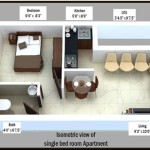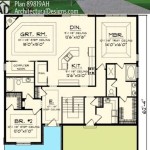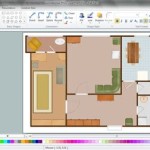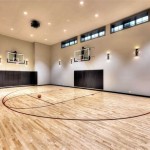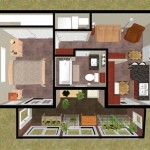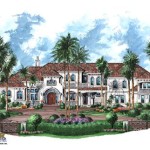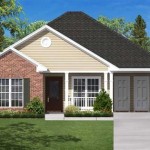Home Plans on Sloped Lots: Maximizing Space and Potential
Building a home on a sloped lot presents unique challenges and opportunities. Unlike flat, uniform land, a sloped lot demands careful consideration during the design and construction phases. However, with thoughtful planning and the right home design, a sloped lot can be transformed into a distinctive and valuable property, offering stunning views, enhanced privacy, and creative architectural possibilities.
The success of building on a sloped lot hinges on understanding the specific site conditions, including the degree of the slope, soil composition, drainage patterns, and potential for erosion. A comprehensive site assessment by qualified professionals, such as engineers and geologists, is crucial before finalizing any home plans. This assessment informs the design process and helps identify potential risks and opportunities associated with the terrain.
Choosing the appropriate home plan is essential for optimizing space, minimizing excavation costs, and integrating the house seamlessly into the landscape. Several types of home plans are well-suited for sloped lots, each offering distinct advantages depending on the specific characteristics of the site.
Walkout Basement Designs
Walkout basement designs are a popular choice for sloped lots, particularly those with a gentle to moderate slope. This design leverages the natural terrain to create a basement level that opens directly to the outdoors. The back of the house is essentially embedded into the slope, while the front is exposed, allowing for natural light and access to a backyard or patio area. A key advantage of this design is the increased living space without significantly increasing the building's footprint. The walkout basement can be finished and used as additional bedrooms, a family room, or a home office, effectively doubling the livable area of the house.
Furthermore, walkout basements can add considerable value to the property. From a construction standpoint, this design can be more cost-effective than completely excavating a basement, as it utilizes the existing slope to create a natural barrier. However, proper drainage and waterproofing are critical to prevent moisture problems and ensure the longevity of the structure. Retaining walls may also be necessary to stabilize the soil and prevent erosion. The design should carefully consider the placement of windows and doors to maximize natural light and ventilation in the basement area. The entry to the backyard should be designed to blend seamlessly with the natural landscape and provide easy access to outdoor living spaces.
The orientation of the house on the slope is also a critical factor. Positioning the walkout basement to face south can maximize sunlight exposure, making the basement more comfortable and energy-efficient. Landscaping can further enhance the aesthetic appeal of the walkout basement by creating a natural transition between the house and the surrounding environment.
Split-Level Designs
Split-level homes are another excellent option for sloped lots, especially those with a moderate to steep slope. This design incorporates multiple levels staggered vertically, with short flights of stairs connecting each level. The staggered levels follow the contour of the slope, minimizing the need for extensive excavation and grading. A key characteristic of split-level homes is the visual separation of living spaces, providing distinct areas for different activities. Typically, split-level homes feature an entry level, a living area level slightly above, and a bedroom level above that. A lower level, partially below grade, can serve as a garage, recreation room, or additional living space.
The design of a split-level home can be highly adaptable to the specific slope of the lot. By carefully adjusting the levels, the house can be integrated seamlessly into the terrain, preserving the natural landscape. The staggered levels also offer opportunities for unique architectural features, such as large windows that capture panoramic views. The split-level design is generally more cost-effective than building a traditional two-story home on a steep slope, as it reduces the need for extensive foundation work. However, the design should consider accessibility for individuals with mobility issues, as the multiple levels require navigating stairs. Elevators or ramps can be incorporated into the design to improve accessibility, but these will add to the overall cost.
The exterior design of a split-level home can be customized to reflect a variety of architectural styles. Varying rooflines and cladding materials can enhance the visual interest of the house and create a distinctive curb appeal. Thoughtful landscaping can further integrate the house into the natural environment by creating terraced gardens or retaining walls that follow the contour of the slope.
Pier and Beam Foundations
For steep slopes or unstable soil conditions, a pier and beam foundation offers a viable alternative to traditional foundation systems. This type of foundation involves supporting the house on a series of piers or posts that are anchored deep into the ground. The piers are typically made of concrete or steel and are spaced strategically to distribute the weight of the building evenly. A network of beams connects the piers, creating a stable platform on which the house is built. One of the primary advantages of a pier and beam foundation is its ability to adapt to uneven terrain without requiring extensive excavation or grading.
This approach minimizes soil disturbance and reduces the risk of erosion, making it an environmentally friendly option. Pier and beam foundations also provide excellent drainage, preventing moisture from accumulating beneath the house. The raised floor elevation allows for airflow beneath the structure, which can help prevent mold and mildew growth. This foundation type is also resistant to seismic activity, as the flexible piers can absorb ground movement. While pier and beam foundations can be more expensive than traditional foundations, the long-term benefits, such as reduced maintenance costs and improved structural stability, can make them a worthwhile investment. Careful consideration should be given to the design of the piers and beams to ensure they are adequately sized to support the weight of the house and withstand environmental forces.
The space beneath the house can be utilized for storage or utilities. However, it is essential to ensure that the space is properly ventilated to prevent moisture problems. The exterior of a pier and beam foundation can be clad with a variety of materials to enhance its aesthetic appeal. Trellises, landscaping, or decorative panels can be used to conceal the piers and create a more visually appealing foundation. A well-designed pier and beam foundation can seamlessly integrate the house into the landscape, creating a strong and stable structure that is both functional and aesthetically pleasing.
Beyond these specific design types, the overall architectural style must also complement the natural surroundings. A modern, minimalist design might contrast sharply with a heavily wooded, natural landscape, while a more rustic or craftsman-style home might blend seamlessly. The choice of materials, colors, and landscaping should contribute to a cohesive design that enhances the beauty of the site.
Furthermore, site-specific considerations, such as the prevailing winds, sun angle, and views, should influence the orientation and layout of the house. Orienting the house to maximize sunlight exposure can reduce heating and cooling costs, while strategically placing windows and decks can optimize views and create outdoor living spaces that are protected from the elements. The overall design should be sustainable and energy-efficient, minimizing the environmental impact of the building and reducing long-term operating costs. This can be achieved through the use of energy-efficient windows, insulation, and appliances, as well as the incorporation of renewable energy sources, such as solar panels.
Landscaping plays a crucial role in integrating the house into the landscape and preventing erosion. Native plants are well-suited to the local climate and require less maintenance than exotic species. Terracing and retaining walls can be used to create level areas for gardens or patios, while drainage systems can help manage stormwater runoff. The overall landscaping design should be aesthetically pleasing and functional, enhancing the beauty of the site while protecting the soil and preventing erosion. The design process requires a collaborative effort between the homeowner, architect, engineer, and landscape designer. Open communication and a shared vision are essential for creating a successful project that maximizes the potential of the sloped lot.
Building on a sloped lot presents both challenges and opportunities. By carefully considering the site conditions, choosing the appropriate home plan, and working with qualified professionals, it is possible to create a distinctive and valuable property that seamlessly integrates into the natural landscape.

Plan 51696 Traditional Hillside Home With 1736 Sq Ft 3 Be

Looking For The Perfect Affordable Cottage With A Large Covered Balcony Plan 1143

Modern House Plan Sloping Lot Contemporary Style 5590 Vista

Sloped Lot House Plans Down Slope The Designers

Duplex For A Down Sloping Lot 8188lb Architectural Designs House Plans

Home Plan Ch507

Modern House Plans For Sloped Lots Fresh 29 Best Steep Slope Images On Sloping Lot Plan Design

Sloped Lot House Plans With Walkout Basements At Dream Home Source Unique Modern Architecture

A Guide To Sloping Lot House Plans

House Plans Home Designs


